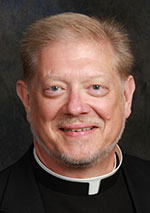That All May Be One / Fr. Rick Ginther
Risk of dialogue with other faiths can bear much fruit
 I have often written in this column about dialogue. Ecumenical and interreligious relations exist and thrive through dialogue.
I have often written in this column about dialogue. Ecumenical and interreligious relations exist and thrive through dialogue.
As has been said before, dialogue is not winning an argument about differences (debate). Nor is it merely laying out a system of beliefs (that can be done in print).
Dialogue is about finding common ground, followed by listening intently to another’s beliefs, traditions and values. Next comes one’s own beliefs, traditions and values.
And then, pondering what was received, a movement toward mutual understanding begins.
Ultimately, this engenders a deep respect for the other. And as movement toward finding understanding among the differences continues, more common ground naturally follows.
Differences remain. But the differences do not end the relationship. And therein lies the key, doesn’t it?
One might imagine that dialogue is the work of professional theologians and leaders of denominations. As described above, that would be correct for the most part.
However, we all are included in dialogue.
The document “Dialogue and Proclamation,” released on May 19, 1991, by the Pontifical Council for Interreligious Dialogue, identifies four forms of dialogue:
Dialogue of life, where people strive to live in an open and neighborly spirit, sharing their joys and sorrows, their human problems and preoccupations.
Dialogue of action, in which Christians and others collaborate for the integral development and liberation of people.
Dialogue of theological exchange, where specialists seek to deepen their understanding of their respective religious heritages, and to appreciate each other’s spiritual values.
Dialogue of religious experience, where persons, rooted in their own religious traditions, share their spiritual riches; for instance, with regard to prayer and contemplation, persons share their faith and ways of searching for God and the absolute.
Granted, this document addresses dialogue among Christians and non-Christians. However, the four forms are universal in character.
The third form of dialogue is for the professionals. The first, second and fourth are for everyone.
The neighbor is the root of the first form. “Who is my neighbor?” (Lk 10:29) the scribe asked Jesus. The neighbor is the one closest to us. They live next door, down the street, work next to us. They are a part of our life, if we simply engage them as described.
Action roots the second form. Our parishes and institutions can easily engage in this form through ecumenical and interreligious outreach—local, national and worldwide. Remembering that “we” are our parishes and institutions, we can act out this dialogue.
Religious experience anchors the fourth form. Throughout history, people have always sought the divine through religious experiences. We have religious experiences—individual and communal prayer, the depth of contemplation, and ways of searching for connection to God. What a marvel to learn of others’ prayer, contemplation and search, while sharing our own.
Each form of dialogue carries a risk.
The first and second require engagement with others in common life and common purpose. The risk is to admit the common, to search it out together.
The fourth requires the risk of intimacy. Our relationship and search for God is very personal. To reveal how we pursue this hope and longing demands a trust of the other.
And yet, what is life without risk? The fruits of taking the risk are manifold.
Take the risk. Step into the dialogue!
(Father Rick Ginther is director of the archdiocesan Office of Ecumenism. He is also pastor of Our Lady of Lourdes Parish in Indianapolis.) †
 I have often written in this column about dialogue. Ecumenical and interreligious relations exist and thrive through dialogue.
I have often written in this column about dialogue. Ecumenical and interreligious relations exist and thrive through dialogue.